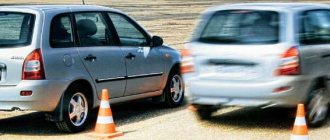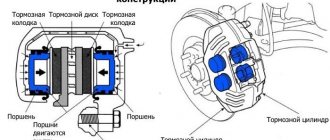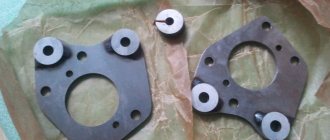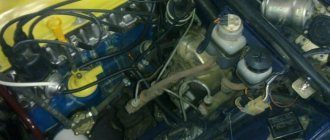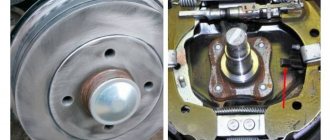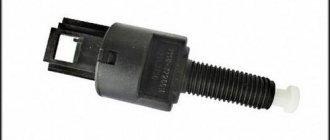Lada Kalina
Most motorists know: disc brakes are more efficient and much more tolerant of stress than drum brakes. Even skeptics will probably agree, although they will immediately object: such brakes are more expensive (including in operation) and the discs are much less tolerant of dirt, which is very important, for example, for all-terrain vehicles. In general, there is something to discuss here.
I remembered a comparative test of two cars that were similar in weight and power consumption. They differed, in particular, in the rear brakes: one had disc brakes, the other had drums. Which of them won in the absolute, I confess, I don’t remember. But the difference in the length of the braking distance - only half a meter - is firmly etched in my memory.
But when the opportunity arose to evaluate the rear disc brakes on a regular Kalina, I couldn’t refuse. A prerequisite is no handicraft and the presence of a certificate of conformity that allows you to pass a state technical inspection.
We decided to test two similar sets of different ones (Darbis) uses the scheme of the first Ford Focus. (AST) preferred the design of the Chinese Chery. We install, test, measure...
Replacing front drum brakes with UAZ disc brakes
There are many options for replacing drum brakes with disc brakes on UAZs, so we will consider only one of them. So, we carry out the work on a UAZ-31512 car with a “civilian” axle (on the front axle, we perform the replacement alternately, first on one side, then on the other):
- remove the wheel;
- dismantle the hub;
- unscrew the three screws, remove the drum, but first use an eccentric bolt to bring the brake pads together;
- Using a hub wrench, unscrew the two nuts and remove the hub;
- unscrew the bolts securing the brake shield, remove the shield assembled with the pads, having first disconnected the tube from the cylinder;
- dismantle the axle;
- We place a gasket under the axle, coat it with sealant, and attach installation faceplates on top of the axle to secure the caliper;
- mount the hub, tighten it with a nut;
- We put a disk on top of the hub;
- we install the caliper assembly with brake pads on the faceplate, here it is important not to confuse the right and left calipers - it is necessary that the bleeder fitting faces up during installation;
- connect the caliper with the hose, install the hub in place;
- to connect the brake pipe with the hose, you will need an adapter;
- bleed the brakes and put the wheel in place.
To assemble such a design, calipers from the GAZ-3302 (Gazelle) car are suitable; exactly the same calipers are installed on the GAZ-3102 Volga for wheels of 14th radius. Faceplates from Otad are installed under them without widening the wheel track.
BEHIND THE LINE INSTRUCTIONS
I admit, there were moments when I wanted to give up everything and return Kalina to regular brakes. First, when dismantling the hubs, the rear bearings, which were thoroughly stuck to the axles, fell apart, and had previously been running for 70,000 km without any unnecessary sounds. Then, already when assembling the first “foreign” kit, for some reason the length of the handbrake cable was not enough and we had to quickly come up with ways to extend it.
Not to mention such “little things” as individual adjustment of the anti-lock braking system sensors (they began to cling to the discs) or an unexpected leak in the brake hose seal. Having spent a total of ten hours installing two sets, I was convinced that it was better to entrust the work to a professional. And if the desire to twist the nuts yourself still prevails, you need to stock up on pullers, consumables and patience.
Running in and lapping is a separate issue. After installing the Darbis kit, the car suddenly stopped rolling normally. And as soon as the brakes warmed up even a little, such a hum and creaking began that experienced drivers of neighboring trucks shuddered. Gradually everything got better, but it was not possible to get rid of the extraneous sounds, clearly associated with the unimportant release of the brake pads.
Dependence of the Lada-Kalina braking distance on the number of brakings; V = 100–0 km/h.
Dependence of the Lada-Kalina braking distance on the number of brakings;
V = 100–0 km/h. Dependence of the Lada-Kalina braking distance on the number of brakings; V = 100–0 km/h.
But there is also a driving sensation. They allow you to quickly feel a noticeable difference in deceleration control, not to mention the specific smell of burning linings, thanks to which a car with drum brakes is easily recognizable by smell.
After installing the discs in both cases, the brake pedal became lighter and more responsive. The car yaws much less, regardless of braking loads. Now the slowdown can not only be dosed fairly roughly, it can be controlled. But the pedal travel of the Kalina is still large and far from that of a foreign car. Sometimes it even seems like he was smaller on the drums! The point is different: the brakes in the basic version were characterized by inertia and there was enough parasitic effort. Simply put, the force on the pedals did not cause the car to respond as expected.
Overview of individual elements
Diagram of the Kalina brake system:
| 1, 5, 13, 16 | Brake mechanism of the Kalina front wheel, including pads, caliper, disc, cylinder |
| 13, 16 | Brake mechanism of the Kalina rear wheel - pads, drum, cylinder |
| 2, 6, 12, 17 | Hoses going to the cylinders |
| 3, 7, 11, 18 | Tubes |
| 4 | Brake Master Cylinder (Brake Master Cylinder) |
| 8 | GTZ tank |
| 9 | Vacuum brake booster (VUT) |
| 10 | Brake pedal |
| 14 | Fluid pressure regulator in the TC of the rear wheels |
| 15 | Regulator knob |
GTZ and brake pedal
The main brake cylinder has not undergone any changes compared to previous Lada models like the VAZ-2110. It is attached to the vacuum brake booster and the force from the brake pedal is transmitted through the VUT.
On top there is a tank with two sections and with measuring notches to control the liquid level. A sensor located in the reservoir lights up an indicator on the dashboard when the brake fluid level drops.
Tubes extend from the GTZ to both circuits. It is due to the main cylinder that the fault tolerance of the entire structure increases. When the vacuum booster rod enters the cylinder and pushes the first piston, the primary circuit pressure increases and the brakes are applied. Due to the pressure, the second circuit also operates synchronously, providing uniform force on both axes.
Master brake cylinder
Since the car is front-wheel drive, the circuits are located diagonally, evenly distributing the force in case of failure of one of the circuits. For rear-wheel drive vehicles, the contours are divided into axles:
- first circuit – front axle;
- the second is the back.
The brake pedal is standard. The exact same one is installed on many Lada cars, there are no differences. It is attached directly to the vacuum booster.
The brake pedal article number is 1118-3504010. Price around 300 rubles;
GTZ article number – 1118-350501082. Costs about 1500-2000 rubles.
The vacuum brake booster, like power steering, is designed to reduce the amount of force applied. The driver of a car without VUT would have to press the brake pedal hard, reducing safety and driving comfort.
The vacuum unit works due to the difference in air pressure that creates force. It consists of two chambers - atmospheric, into which ambient air enters, and vacuum, connected to the exhaust pipe of the engine.
UNTIL FAILURE
The real truth in the characters of the brakes only appears when you force them to work hard. At first, when you accelerate the Kalina to 160 km/h, you mockingly think: “Can it?” When it's time to brake to the floor, there is no place for jokes. The antics of the drum version force you to grip the steering wheel harder in advance.
At the same time, there is no doubt that the car will still show character and will “look for the road” for the entire 130-odd meters, actively scouring from side to side. Not strong (with an amplitude of about a meter and a half), but very persistent. Discs provide not only a reduction in braking distance, but also more stable behavior. The difference is clearly visible at a lower speed of 120 km/h. Here the Kalina with disc brakes stops like a bullet, while the drums again doom it to a slight, but clearly excessive independence.
RESULTS OF MEASUREMENTS OF LADY-KALINA BRAKING DISTANCE, m
The chief “Kalinovod” of the editorial staff, Maxim Sachkov, ended up liking the Darbis brakes more, as they were more rigid. But for me, on the contrary, the AST version. Perhaps because I was present during the installation of both systems, delving into all the flaws, and then began running-in. The AST product seemed more complete, convenient, and brought to a good consumer level.
In general, I’m in favor of all-round wheels even on a regular Kalina. And not at all because of their resistance to loads or high speeds. Feelings are more important. Well, now we just have to pass the last test - technical inspection...
Rear disc brakes for Lada Kalina: still images
Features of the brake system replacement process
The process of replacing a drum brake with a disc brake system has many features to consider. The car's brakes are the main safety system that guarantees the life of the driver if they function correctly.
When purchasing disc brakes for a specific car model, you need to make sure that the spare parts are original and have passed Russian standardization, otherwise you may have problems when passing the next mandatory vehicle inspection. Since replacing brakes is a design change, state vehicle inspection experts will definitely pay attention to this.
One of the negative features of replacing brakes is that in the event of an accident, traffic police officers may, without explanation, consider the driver of a car who has unregistered design changes to be the culprit of the accident.
Replacing brakes must be carried out strictly according to the instructions in compliance with all requirements for the specific make and model of the car. Otherwise, the brake system may be adjusted incorrectly and the vehicle's braking performance may be reduced.
